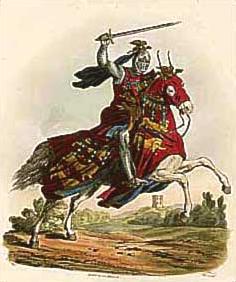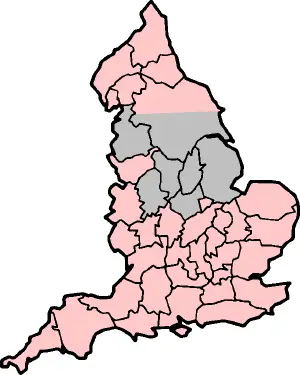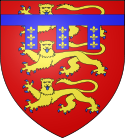Thomas Plantagenet, 2nd Earl of Lancaster
Thomas, Earl of Lancaster (c. 1278 – March 22 1322) was one of the leaders of the baronial opposition to Edward II of England. A descendant of Henry III of England, Edward was his cousin. Thomas Lancaster led two rebellions against Edward. The first, in 1310, resulted in Parliament imposing restraints on Edward's profligate spending and imposition of a supervisory council, which Thomas headed. From 1314 until 1318, Thomas effectively governed England. In 1321, following more years of miss-rule, he again headed a revolt. This time, he and his supporters were defeated. Thomas was found guilty of treason and executed. One of his fellow rebels, however,
Roger Mortimer, 1st Earl of March escaped from prison and later led a successful coup against Edward, who was deposed.
Lineage
Thomas was the eldest son of Edmund Crouchback, 1st Earl of Lancaster and Blanche of Artois. His paternal grandparents were Henry III of England and Eleanor of Provence. His maternal grandparents were Robert I of Artois and Matilda of Brabant, who was a daughter of Henry II, Duke of Brabant.
Titles and lands
From his father Thomas inherited the Earldoms of Lancaster, Leicester, and Derby.
By his marriage to Alice de Lacy, Countess of Lincoln, daughter of Henry de Lacy, 3rd Earl of Lincoln, he became Earl of Lincoln, Earl of Salisbury and the 11th Baron of Halton upon the death of his father-in-law in 1311. Master of five earldoms, he was one of the wealthiest and most powerful men in England.
Thomas was in possession of many key fortesses, particularly in northern England. He was responsible for the extension of Pontefract Castle and in 1313 he began the construction of Dunstanburgh Castle a massive fortress in Northumberland.
Marriage
His marriage to Alice de Lacy was not successful. They had no children, though he had two illegitimate sons. In 1317 she was abducted from her manor at Canford, Dorset by Richard de St Martin, a knight in the service of John de Warenne, 8th Earl of Surrey. This incident caused a feud between Lancaster and Surrey; Lancaster divorced his wife and seized two of Surrey's castles in retaliation. King Edward then intervened, and the two Earls came to an uneasy truce.
Although divorced from his wife, he continued to hold the powerful Earldoms of Lincoln and Salisbury. This was due to the marriage contract the two families had agreed, in effect upon the death of his father-in-law, Earl Thomas held these earldoms in his own right, not in right of his wife.
Conflict with Edward II and death
He served in the coronation of his cousin, King Edward II of England, on February 25, 1308, carrying Curtana, the sword of St Edward the Confessor. At the beginning of the King's reign, Lancaster openly supported Edward, but as the conflict between the king and the nobles wore on, Lancaster's allegiances changed. He despised the royal favorite, Piers Gaveston, who mocked him as "the Fiddler", and swore revenge when Gaveston demanded that the King dismiss one of Lancaster's retainers.[1]
Lancaster was one of the Lords Ordainers who demanded the banishment of Gaveston and the establishment of a baronial council to oversee England's governance. Parliament passed regulations that restricted Edward's ability to spend, and to act without consultation. His private army helped separate the King and Gaveston, and Lancaster was one of the "judges" who convicted Gaveston and saw him executed. Edward was infamous for his profligacy, and love of entertainment.
After the disaster at Bannockburn in 1314 when he was defeated by Robert I of Scotland, Edward submitted to Lancaster, who in effect became ruler of England. He attempted to govern for the next four years, but was unable to keep order or prevent the Scots from raiding and retaking territory in the North. In 1318 a new faction of barons arose, and Lancaster was deposed from office.
The new leadership, eventually headed by Hugh le Despenser, 1st Earl of Winchester and his son Hugh Despenser the younger (Edward's Chamberlain), proved no more popular with the Baronage, and in 1321 Lancaster was again at the head of a rebellion. The rebel barons convinced Parliament to banish both Despensers, who went into exile in August 1321. Hugh became a pirate in the English Channel, "a sea monster, lying in wait for merchants as they crossed his path."[2] Edward, however, was determined to crush to rebellion and recall his chamberlain, moved decisively against the rebellion.
Lancaster and his allies were defeated at the Battle of Boroughbridge, and he was taken prisoner.
Lancaster was tried by a tribunal consisting of, among others, the two Despensers, whom Edward had immedfiately recalled and re-instated, Edmund FitzAlan, 9th Earl of Arundel, and King Edward himself. Lancaster was not allowed to speak in his own defense, nor was he allowed to have anyone to speak for him. Because of their kinship and Lancaster's royal blood, the King commuted the sentence to mere beheading (as opposed to being drawn, quartered, and beheaded) and Lancaster was convicted of treason and executed near Pontefract Castle. One of the other leading rebels, Roger Mortimer, 1st Earl of March, who had served as Edward's Lord Lieutenant of Ireland but who had become disgusted with Edward's profligacy, was imprisoned but managed to escape toFrance. The following year, Edward's wife, Isabella of France visited her brother, the French king to mediate in a dispute with Edward, who refused to pay homage for his fief in Gascony. In France, however, Isabella became Mortimer's lover, and the two plotted against Edward.
The tyranny
The four years that followed became known as "The tyranny". Hugh Despenser the Younger more or less ruled the country, without consulting Parliament or the barons. He accumulated vast personal wealth by dispossessing legal heirs, especially widows. For four years," writes Given-Wilson, "Edward and the Despensers ruled England as they pleased, brooking no opposition, growing fat on the proceeds of confiscated land and disinherited heirs."[3] Edward and the Despensers ignored the law of the land, bending it to suit their interests.
In 1326, and Roger Mortimer and Edward's now estranged Queen, Isabella, finally invaded England. Edward had hardly any allies, and before long was imprisoned and deposed. The invasion force was rather small but many soldiers simply refused to fight against Mortimer. King Edward was placed in captivity and later deposed. Hugh's father was executed, at Bristol, and Hugh himself was brought to trial. Unlike Lancaster, Hugh was drawn and quartered; indeed, his execution was particularly gruesome. He was dragged behind four horses to his place of execution, where a great fire was lit. He was then stripped naked, and biblical verses denouncing arrogance and evil were written on his skin. Next, he was hanged from a gallows 50 ft (15 m) high, but cut down before he could choke to death, and tied to a ladder, in full view of the crowd. Climbing up beside him, the executioner sliced off his penis and testicles which were then burnt before him, while he was still alive and conscious. Finally, his corpse was beheaded, and his body cut into four pieces, and his head mounted on the gates of London[4]
Lancaster's Posthumous Pardon
In 1326 or 1327 Parliament posthumously reversed Thomas's conviction, and Henry Plantagenet was further permitted to take possession of the Earldoms of Lancaster, Derby, Salisbury and Lincoln.
Thomas became venerated as a martyr and saint within a few months of his death. Hagiographies were written about him, and Edward III wrote three times to the Pope requesting his canonization. He was never canonized, though rumors to that effect arose in the 1390s, when his cult experienced something of a revival.
After his death his titles and estates were forfeited, but in 1323 his younger brother Henry successfully petitioned to take possession of the Earldom of Leicester.
Parliament and the Governance of the Realm
Throughout Edward II's reign, Parliament tried to curb his excesses. In 1010-11, Parliament had tried to limit Edward's power and spending. Following the restoration of the Despensers in 1322, Edward issued a statute revoking these ordinances, and began to ignore parliament completely. Yet, although he ignored Parliament, by the end of his life, Parliament was beginning to assert the right to share in power. It appropriated to itself the task of curbing excesses and of minimizing the possibility of one person, king or a manipulator of kings, ignoring on people's rights, confiscating their property and governing with no concern for the common good. In the end, it was parliament that deposed Edward and it was Parliament that confirmed Edward III of England as his successor. Thomas Lancaster was of the view that the king, like the king's subjects, was under not above the law.
Legacy
Thomas Lancaster's own reputation improved with age. He has been described as "a coarse, selfish and violent man, without any of the attributes of a statesman"[5] and as "vindictive, greedy and cruel, and lethargic when presented with real power."[6]
Titles, styles, honors and arms
Arms
Inherited from his father, Thomas bore the arms of the kingdom, differenced by a label France of three points (that is to say azure three fleur-de-lys or, each).[7]
Notes
- ↑ Mortimer, page 51.
- ↑ Mortimer. 2006. page 111.
- ↑ Given-Wilson. 1987. page 32.
- ↑ Mortimer, page 160.
- ↑ Chisholm, Hugh. 1911. The Encyclopædia Britannica: A Dictionary of Arts, Sciences, Literature and General Information. NY: The Encyclopedia Britannica company. page 148.
- ↑ Arnold-Baker, page 176.
- ↑ Marks of Cadency in the British Royal Family. British Heraldry Page. Retrieved October 21, 2008.
ReferencesISBN links support NWE through referral fees
- Arnold-Baker, Charles. 2001. The companion to British history. London: Routledge. ISBN 9780415185837
- Given-Wilson, Chris. 1987. The English nobility in the late Middle Ages: the fourteenth-century political community. London, UK: Routledge & Kegan Paul. ISBN 9780710204912.
- Mortimer, Ian. 2006. The greatest traitor: the life of Sir Roger Mortimer, ruler of England, 1327-1330. New York, NY: Thomas Dunne Books. ISBN 9780312349417.
Credits
New World Encyclopedia writers and editors rewrote and completed the Wikipedia article in accordance with New World Encyclopedia standards. This article abides by terms of the Creative Commons CC-by-sa 3.0 License (CC-by-sa), which may be used and disseminated with proper attribution. Credit is due under the terms of this license that can reference both the New World Encyclopedia contributors and the selfless volunteer contributors of the Wikimedia Foundation. To cite this article click here for a list of acceptable citing formats.The history of earlier contributions by wikipedians is accessible to researchers here:
The history of this article since it was imported to New World Encyclopedia:
Note: Some restrictions may apply to use of individual images which are separately licensed.


